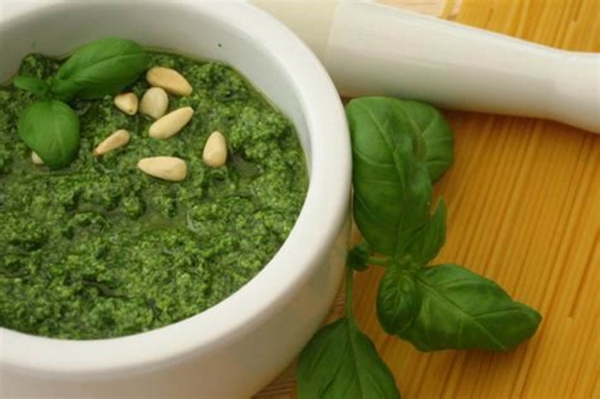Let's delve into this delicious and aromatic world. Experts claim that truly authentic basil is the one cultivated on "terraces" (strips of land carved out of inhospitably steep hills) until fifty years ago, along the legendary area stretching from Pegli to Prà, characterized by a special microclimate which blesses the small leaves of this plant with a truly special fragrance. Today things have changed. Terrace cultivation is a primordial practice on the brink of extinction: there are perhaps two or three remaining producers. We first saw the timid rise of greenhouse cultivation back in the 1920s and 30s. It has since become standard practice for basil cultivation along the entire Ligurian Arch. Another "thorny" issue is whether or not a modern blender can be used to make pesto, instead of the more choreographic but somewhat impractical mortar. Shredding, mashing, pulverizing and mixing: stone, bronze or wooden mortars were once used for such operations. In the kitchen, a marble or stone mortar has always been used with a wooden pestle (cherry, pear, boxwood), all much softer materials which do not chip stone. It remains the ideal receptacle for making pesto, because the gradual grinding of ingredients creates an aromatic harmony and creaminess unobtainable any other way. Blender use has polarized opinions, yet there is universal consensus as to the uniqueness of "Ligurian" basil compared to varieties cultivated in other Italian regions, or even imported from other Mediterranean countries.
And yet basil is not originally native to Italy. It came from a far-off land, India, where it is sacred to Vishnu. Worshippers of this divinity use basil seed rosaries and even wear bracelets and necklaces made from the root of this plant. In Greek, "Basilikòn" means "regal" and as such, basil should be considered a "royal herb" to commemorate its rarity in ancient times. Upon arriving on our shores, imported by navigators who sailed the seas in precarious vessels, spurred on by passion and a desire to make their fortune, basil acclimated well and Liguria proved to be its ideal habitat. You could be mistaken for thinking that a "Ligurian" basil plant that is replanted or taken to another region in its pot would remain unaltered in terms of flavor. Nothing could be further from the truth. Removed from its natural climate and deprived of the minerals of the special local soil, Ligurian basil grows, but its flavor changes. It is not unpleasant, but it no longer tastes "Ligurian" in that it is no longer characterized by the aforementioned properties which earned it "Protected Denomination of Origin" (PDO), a guarantee of maximum protection for typical local agricultural products.
There are at least 60 types of basil around the world. "Genoese" basil is undoubtedly one of the most widespread varieties, characterized by a sharp aroma and delicious used fresh. "Neapolitan" broad-leaf basil has a more delicate aroma, a minty flavor and is better suited for drying; "mammoth" basil is a lettuce-leaf variety, also suitable for drying.
The most flavorsome leaves are those picked just before flowering as they have a higher content of oily substances, resulting in an enhanced aroma. The leaves of older plants have a slightly spicier flavor than others. Whatever you pick, you should never shred it with a knife because leaves develop flavor-altering substances upon coming into contact with metal.
The preparation of pesto demands quality olive oil. 50% of olives cultivated in Liguria are of the noble taggiasca variety, which are used to make an extra virgin olive oil of unrivalled quality. It triumphs over all other sweet extra virgin olive oils in virtue of its fine and delicate flavor, perfect qualities for making a good pesto.
All good! Now let's take a look at the recipe for this fantastic condiment. Here it is: wash and dry the leaves of four bunches of basil; crush one garlic clove in the mortar with a little salt, gradually add the basil leaves and continue to crush the mixture. Now add 30 g of pine nuts and grind all the ingredients down into a homogeneous mixture; add 70 g of Parmigiano Reggiano and 30 g of Sardinian Pecorino (no imitation cheeses please!). Mix everything together using the pestle. To finish off, add 10 centiliters of extra virgin taggiasca olive oil and carefully blend into the mixture to dilute it. Buon appetito! I look forward to seeing you in Liguria!

